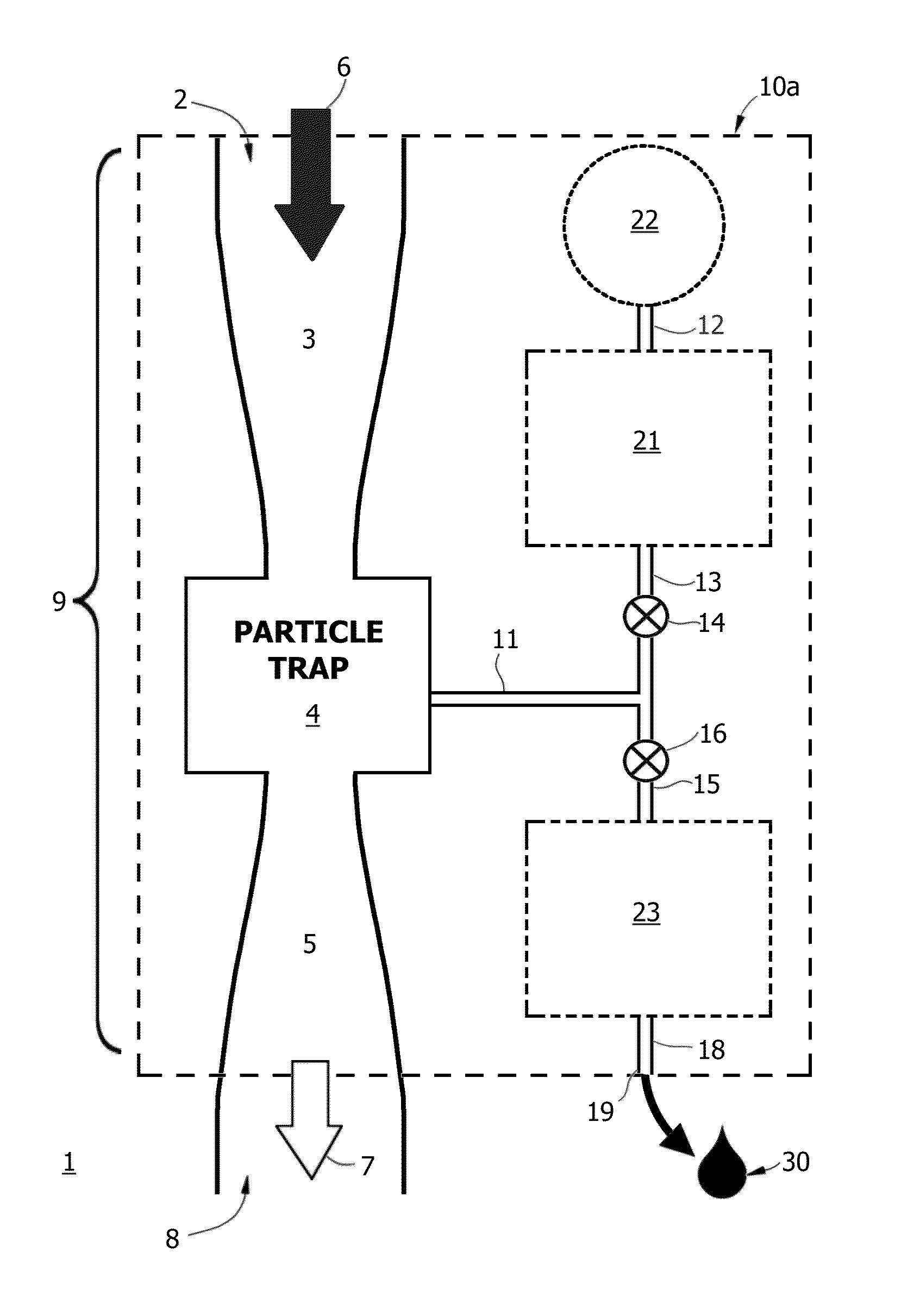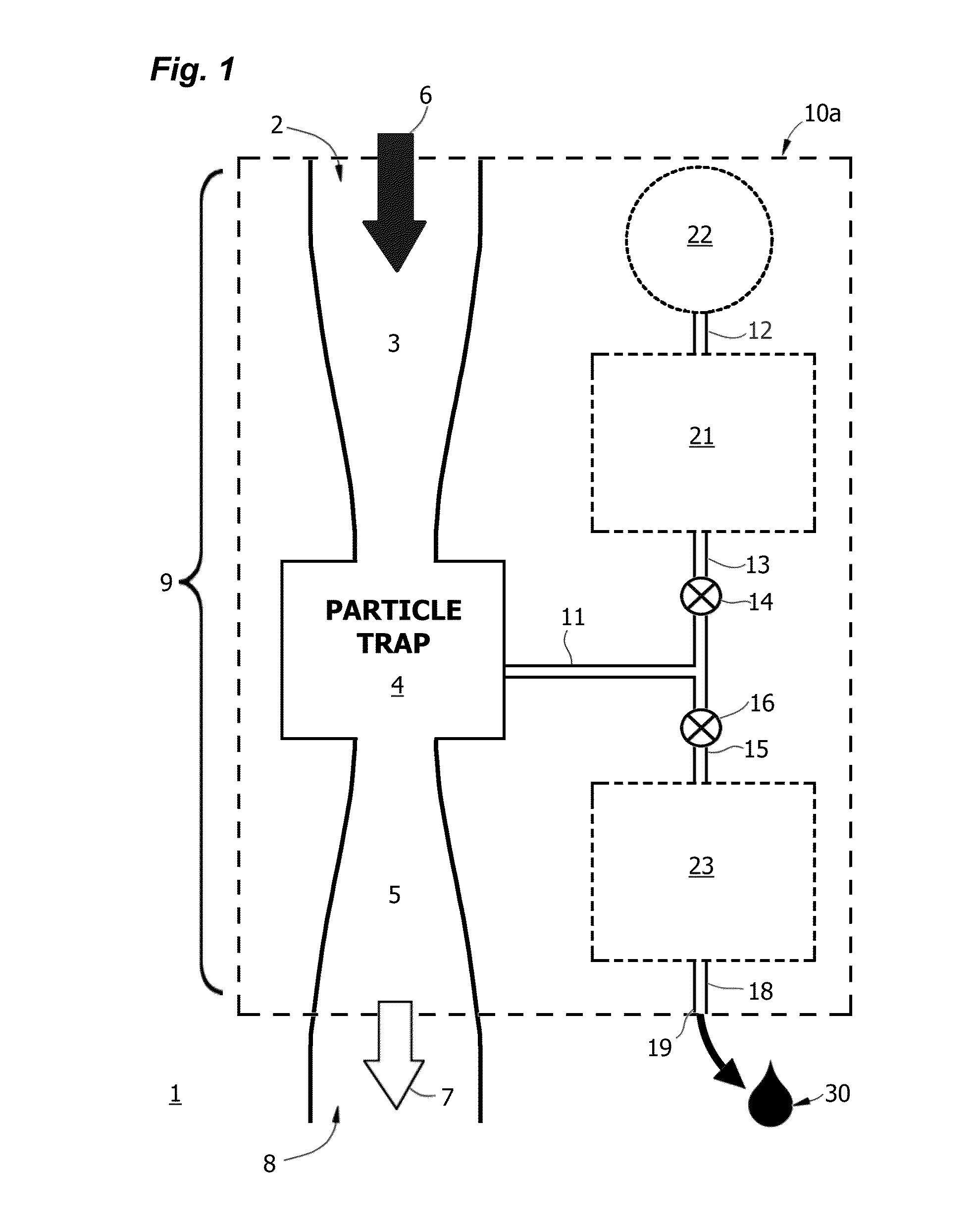Aerosol Collection Apparatus and Methods
a technology of aerosol and collection apparatus, which is applied in the direction of nanoparticle analysis, cleaning using liquids, instruments, etc., can solve the problems of inability to detect bioaerosols, particulates toxins or other aerosol particles of interest, and the inability to adhere to sample materials for many kinds of analyses, so as to prevent particle build-up, remove stubborn deposits, and restore optimal efficiency
- Summary
- Abstract
- Description
- Claims
- Application Information
AI Technical Summary
Benefits of technology
Problems solved by technology
Method used
Image
Examples
example 1
Dry Acoustic Cleaning of an Aerosol Concentrator
[0355]An aerosol concentrator with ADL and skimmer of the type shown in co-assigned U.S. Pat. No. 7,875,095 was set up with flowing air and instrumented to monitor backpressure. ASHRAE dust was then introduced into the feed and backpressure was monitored. After a suitable interval, backpressure in the major and minor flow channels had substantially increased. The skimmer assembly was then subjected to acoustic energy using a piezoelectric horn contacted to the body of the skimmer. Backpressure immediately returned to pre-fouling levels. As shown in the table below, backpressure in the major flow channels was seen to rise from 5.5 to 12 inches H2O with increased narrowing due to accumulation of ASHRAE dust in the channels. Upon application of ultrasound to the body of the assembly, backpressure immediately returned to baseline. Similarly, in the minor flow channel, backpressure rose from 0.3 to 1.8 inches H2O, but returned to 0.3 inches...
example 2
Prophylaxis
[0356]In a second example, prophylactic treatment was demonstrated. Using the setup of Example 1, ASHRAE dust was again introduced into an aerosol concentrator. A flow split of 40:1 was used; with 10 Lpm flow rate in the chimneys and 0.25 Lpm in the collector channel. Rather than permit fouling to occur, ultrasound (33 KHz, 50 W) was applied for 1 second at 2 minute intervals. Backpressure was again monitored.
[0357]After 30 minutes, no increase in backpressure was noted in any of the channels of the device. Contrastingly, backpressure had noticeably increased under control conditions without ultrasonic prophylaxis of fouling. Visual inspection confirmed that particle deposits were prevented by periodic ultrasonic treatments.
Backpressure, Backpressure, Major FlowMinor FlowChannels Channel Experimental(inches H20)(inches H20)Intermittent US30Treatment over 30 minNegative Control30.3
[0358]The reduced duty cycle (1 sec ON at 2 min intervals) reduced energy consumed in the ult...
example 3
Timecourse for Fouling Under Heavy Loading
[0360]Using the setup described in the examples above, the data of FIG. 34 was obtained by monitoring backpressure over a thirty minute interval. Backpressure is reported as percent over baseline. Backpressure in the chimney of the untreated channel continued after ten minutes but increases are not shown because the pressure gauge had reached its maximum reading.
PUM
 Login to View More
Login to View More Abstract
Description
Claims
Application Information
 Login to View More
Login to View More - R&D
- Intellectual Property
- Life Sciences
- Materials
- Tech Scout
- Unparalleled Data Quality
- Higher Quality Content
- 60% Fewer Hallucinations
Browse by: Latest US Patents, China's latest patents, Technical Efficacy Thesaurus, Application Domain, Technology Topic, Popular Technical Reports.
© 2025 PatSnap. All rights reserved.Legal|Privacy policy|Modern Slavery Act Transparency Statement|Sitemap|About US| Contact US: help@patsnap.com



